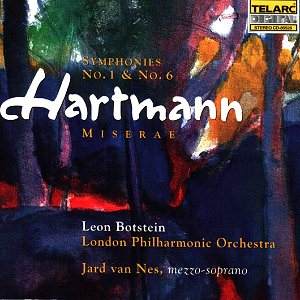
I have already written twice about Hartmann, a German composer whose symphonies
and other works are beginning to find multiple recordings and recognition.
The music combines violence, dissonance and lyricism.
The Wergo set of the complete symphonies is still worth tracking down for
performances of zealous advocacy still giving off the intensity of discovery.
Those discs (originating from very high quality stereo radio tapes) cannot
hope to have the aural finesse delivered by the EMI Metzmacher/Bamberg cycle
(rather sumptuously spread across many discs) and certainly cannot aspire
to the technical heights achieved by Telarc and their interpreters. While
the largely nondescript tone poem Miserae (interesting rather than
compelling) hardly registers despite the high expectations raised by dedication
to victims of Dachau the remainder (most of the disc) is of very high value.
Botstein clearly feels great conviction for this music and this comes across
both in performance and in the booklet text, part of which he contributed.
These are eloquent performances directed by a man who clearly sees Hartmann
as a natural partner to Shostakovich.
The first symphony sets Whitman texts (in German translation - both English
and German are printed in the booklet - though, sadly, not side-by-side)
and it is strange to hear them in an atonal (though fundamentally lyrical)
context. The first movement of No. 1 in its brass and drums onslaught suggests
a chaos of projectiles hurtling out of some abyss. Jard van Nes's singing
is outstanding and, surprisingly, had me thinking of Sibelius's
Luonnotar. The remainder of the work it is rather like encountering
the shades of Holst (especially Saturn) and Stravinsky's Rite of Spring.
Strange maimed creatures shamble through a wasteland of the soul. This is
the sombre land where, in Yeats' words, 'the axle breaks'.
Hearing the sixth symphony is rather a nostalgic experience for me. It reminds
me of the Fricsay 10" LP of the work given to me during the early 1970s.
The symphony is in two movements. The Adagio is something of a slithering
bolero with a touch of the sinuous bassoon theme from The Rite. This is disturbed
by superheated updrafts from the depths, a desperate lyricism and, at the
apex of the movement (8.04), a dire climax of hideously sustained outrage
which then subsides into the quieter marches of nightmare. The finale is
a crepuscular fugue (at first disconcertingly like Reger) which develops
into a hectic rocking roller-coaster juxtaposing jazz and militaristic elements.
Very good notes and superb sound. If I marginally prefer the Berlin Classics
collection of symphonies it is because that offers three symphonies (5,6,8)
even if its sound quality, though very attractive, cannot match the transparency
and impact of the Telarc. The Telarc carries the strongest recommendation
for anyone wanting to encounter Hartmann in the very best sound and in
performances of white heat inspiration. Hartmann's music can be said to have
come of age with this mainstream disc.
Reviewer
Rob Barnett

